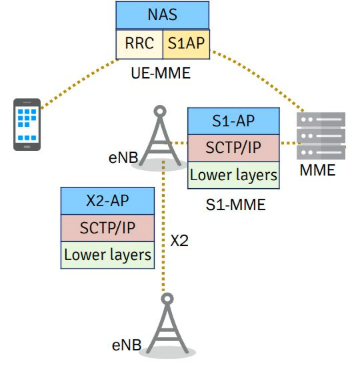The Non-Access Stratum (NAS) protocol is a key component in mobile networks, particularly in LTE (Long Term Evolution), facilitating control-plane signaling between the User Equipment (UE) and the Mobility Management Entity (MME). The NAS layer is responsible for essential procedures such as authentication, registration, session management, mobility management, and security.
Role and Responsibilities of NAS
The NAS protocol performs the following major functions:
- Mobility Management (MM):
- Handling UE Attach and Detach procedures
- Tracking Area Updates (TAU)
- Location Updates and UE state transitions
- Session Management (SM):
- Establishing, modifying, and releasing bearer contexts
- Requesting and managing PDN (Packet Data Network) connectivity
- Security Functions:
- Mutual authentication between UE and network
- Ciphering and integrity protection of NAS signaling
- Idle Mode Handling:
- Paging and service request procedures
NAS Protocol Architecture
NAS sits above the Access Stratum (AS) layer and communicates between the UE and MME via the eNodeB, which acts as a transparent conduit. The message flow structure is as follows:
+-----------------------------------+
| NAS Protocol Layer | <-- Signaling messages (Attach, TAU, etc.)
+-----------------------------------+
| S1-AP (S1 Application Protocol) | <-- Between eNodeB and MME
+-----------------------------------+
| SCTP/IP | <-- Between eNodeB and MME
+-----------------------------------+
UE <---(via eNodeB)---> MME
NAS messages from UE to MME are carried over RRC (Radio Resource Control) to the eNodeB, then over S1-AP to the MME. The eNodeB does not process NAS messages but simply forwards them.
NAS Message Types
- Mobility Management Messages:
- Attach Request / Attach Accept / Attach Complete
- Detach Request / Detach Accept
- Tracking Area Update (TAU) Request / Accept
- Service Request / Service Reject
- Identity Request / Identity Response
- Authentication Request / Response
- Session Management Messages:
- PDN Connectivity Request / Accept
- Activate Default Bearer Request / Accept
- Bearer Resource Command / Modification / Release
NAS Message Flow: LTE Attach Procedure
The LTE attach procedure is a key example of NAS signaling. The typical flow includes:
- UE → MME: Attach Request (NAS)
- MME → UE: Authentication Request (NAS)
- UE → MME: Authentication Response
- MME → UE: Security Mode Command (initiate ciphering/integrity)
- UE → MME: Security Mode Complete
- UE → MME: PDN Connectivity Request
- MME ↔ SGW/PGW: Create Session Request / Response
- MME → UE: Attach Accept
- UE → MME: Attach Complete
LinkedIn: ![]()
